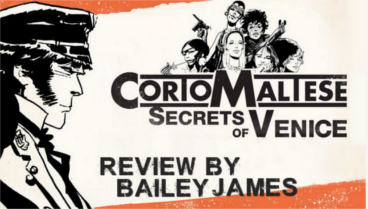
Corto Maltese – Secrets of Venice Review
Secrets of Venice is mostly insulting in its banality and occasionally frustratingly obtuse, resulting in a gameplay experience that is deeply "unfun."
 







Corto Maltese: Secrets of Venice is Kids up hill’s newest adventure game that draws inspiration from the seafaring comic book character of the same name. Sadly, strong source material isn’t enough to buoy a clunky, slapdash failure of a game from crashing and burning on impact. Secrets of Venice is mostly insulting in its banality and occasionally frustratingly obtuse, and the result is a gameplay experience that is deeply “unfun.”
The Story
The character of Corto Maltese originates from a French comic book series by Hugo Pratt that follows the adventures of the sailor as he travels the world and meets a rich array of people. He has a Forrest Gump-like habit of appearing in the middle of historical conflicts like the Russo-Japanese War and the Spanish Civil War, and meets historical figures of note such as James Joyce, Jack London, Butch Cassidy, and William Butler Yeats. I hadn’t known anything about the character before I started playing, but he seems like interesting enough fodder for a game.
Corto Maltese might have been a better experience if the story’s elements had been more effectively utilized. It took me awhile to realize that I wasn’t playing as Corto Maltese, but rather a nameless stranger following in the footsteps of Maltese’s most notable adventures after a clearly suspicious and balding bartender encourages you to drink a concoction revealed to be a powerful poison.
Only by traveling around Venice and collecting ingredients for an antidote that include red wine and human ashes can you prevent the slow-acting but nonetheless potent poison from killing your character. The motive of the poisoner? He assumes that you, an unproven stranger, have what it takes to collect all the emerald petals that can be reassembled to give the bearer magic powers.
At best, the story is far-fetched; at worst, it’s utterly incomprehensible. You’ll run into historical figures from the comics such as the aforementioned Jack London and William Butler Yeats, but the clothing of the other onscreen characters and the presence of technology like speedboats and handguns clearly indicates this is the modern era. Is the poison causing time travel? Hallucinations? It isn’t stated and you’ll never know.
The only real connection to the Corto Maltese comic book series, in fact, is a series of “visions” in which your character can see scenes from various Corto comics, meant to demonstrate how you’re emulating his quests. But this element feels tacked-on and doesn’t serve to ground the story in reality. If you’re familiar with the series, the game will feel like a “greatest hits” overview. If you’re not familiar, you’ll be scratching your head at why Rasputin keeps trying to shoot you and how Jack London ended up in Venice the entire time.
The Gameplay
Secrets of Venice will guide you by the hand through a series of reasonably well-illustrated scenes and force you to click on points of interest, indicated by sparkles, when you “tilt” the scene by clicking and dragging your mouse. It wouldn’t be a bad system if the game world didn’t seem so sparsely populated with details and the clear intent weren’t to get you through the story as quickly as possible.
In addition to the exploration screens, you have a dashboard that holds your compass, which is available whenever there’s a puzzle to be solved. It also holds a “newspaper” with pages and articles that reflect new information when you click on points of interest in the game world. These small articles reveal the history of Corto’s character and six of the women he encountered on his journeys (the six “chapters” of the game are based around the women, each of whom possesses an emerald petal), but they feel scattered and totally removed from the plot of the game. Tidbits about the author’s life are mixed in with perplexing hypotheses about what movies Corto Maltese might have liked (“Today Corto would have been amused by the ‘Pirates of the Caribbean’ films by Gore Verbinski”) which leads to further confusion about whether the makers of the game were hoping to create a new generation of Corto fans or to tickle the curious fancies of current supporters.
To make things even more confusing, the game is unskillfully translated from French, so grammatical errors are relatively frequent. Also, a few small bits of text remain untranslated, including an article in the newspaper and the options menu itself (you’ll have to hope nothing bad happens when you click the option that’s revealed to mute the sound). Also, there’s no quit button on the main menu so you’ll have to manually close the game yourself by shutting it down from your computer’s taskbar. Even a quick cleanup of these kinds of problems would have made the game seem less pushed out the door.
The Puzzles
If there’s anything worse than the story and gameplay, it’s the puzzles. Almost all take place within a compass box and include such basic standbys as the “connect all the colored dots” puzzles and “solve mathematical riddles tangentially related to the current plot” riddles. They’re either insultingly easy or frustratingly obtuse (it took me awhile to figure out the password for an alarm code that makes use of the “turn your calculator upside down and use the numbers to spell words” trick I learned in middle school).
There are two puzzle difficulty levels that can be triggered depending on which code you enter into the compass before starting the puzzle. I was initially impressed by this mechanic before I learned that the two levels aren’t “easy” and “hard,” but “easy” and “use the internet.” What does this mean? The first time I tried it, the instructions were to plug a set of coordinates into a “very well known online mapping service.” And sure enough, when I used Google Maps to locate the name of the island, it proved to be the correct code word.
This maneuver feels like an attempt by the makers of the game to design half as many puzzles as Secrets of Venice should have had. This completely took me out of the world of the game. After all, who wants to stop playing a game and go plug something into a search engine to progress further?
Conclusions
I’d be remiss if I didn’t mention the two bright spots of the game, which are the illustrations and soundtrack. The comic panels pulled from Hugo Pratt’s source material are beautifully drawn and witty (since they had been professionally translated, presumably), and several impressive watercolors of the characters are a pleasing diversion. The game is also well-scored with full orchestral tracks that set the mood well. But these don’t even come close to redeeming this clunky imitation of a fun experience.
My advice? If the character of Corto Maltese sounds interesting to you, go pick up one of the English translations of the comics and read that instead. This game plays like a fever dream and will leave you feeling seasick when you’re done with it three hours after you’ve started. Leave Corto Maltese: Secrets of Venice out in the ocean where it belongs.
+ Beautiful illustrations and a fully scored soundtrack – Incomprehensible plot – Errors and untranslated French portions – Mundane and frustrating puzzles |  |
MINIMUM Windows:
OS: Windows 7
Memory: 1 GB RAM
Hard Drive: 850 MB available space
MINIMUM Mac:
OS: Mac OS 10.5
Memory: 1 GB RAM
Hard Drive: 850 MB available space

Leave a Reply